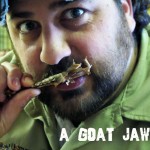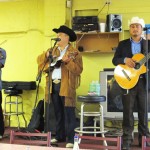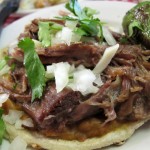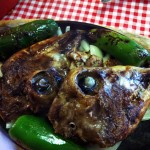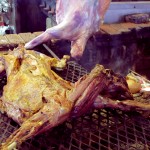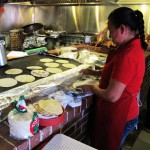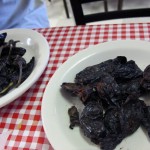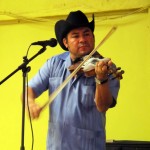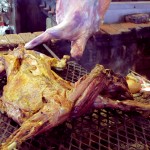Cooking and Eating Baby Lambs and Goats
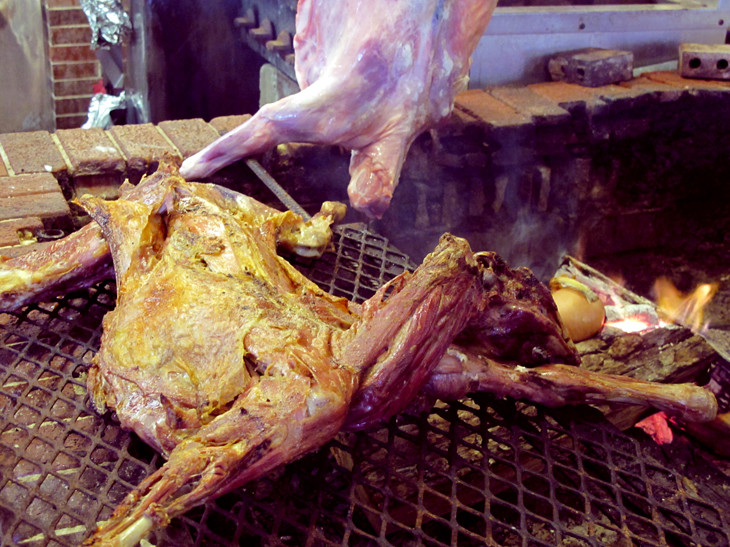 This article was previously posted on 29-95.com.
This article was previously posted on 29-95.com.
Earlier this year, I was introduced to a guy named John Speights; an astute homebrewer, Mexican food aficionado, and fanatic of weird music. While enjoying a Hoppin’ Frog B.O.R.I.S. Oatmeal Imperial Stout in his backyard, I spotted a large circular brick oven, similar to the description in Robb Walsh’s The Tex-Mex Grill and Backyard Barbacoa Cookbook.
“What the hell is that thing?”
“This, my friend, is a brick oven. I use it to cook baby lambs.”
I knew right away that we would be amigos, and that we would share mix tapes, ride bicycles together, and knit one another friendship bracelets.
He explained the process in detail. Before the firepit is built, a large hole is dug out of the ground, and a concrete base is poured in, leaving about a foot and a half of depth. A car tire is used to facilitate pouring the mold. The pit isn’t made of stone bricks, but “fire bricks”, constructed of a ceramic material similar to the inside of a kiln. A special heat-resistant mortar is used when stacking the bricks concentrically. A tight seal is important, so if the bricks or mortar eventually crack, you can use mud to pack in between the cracks. I won’t get into too much detail about the construction of a fire pit, because it’s all over the web and I am not your personal research assistant.
The cooking process can take up to three days. A big fire is lit within the pit, until the bricks are at the correct temperature. At this time, you let the fire burn itself out. A mesh grill is installed over the coals, a pot is placed on top of the grill to collect the meat drippings for birria (a lamb or goat consommé) and another grill is installed above to cook the innocent baby lamb. Although there are countless methods of cooking lamb, he learned this style from his friends in Hidalgo, Mexico.
Leaves of the maguey plant are cut and split, and the seasoned lamb cuts are wrapped in these leaves and tied off with string. You can find these yucca-like leaves in Hispanic produce markets (John prefers to grow his own). John uses lamb testicles in his consommé, along with rice, garbanzo beans, garlic, epazote, and chipotle peppers. Once everything is in place, a tight lid is placed on top and situated so that no air escapes from the pit. Then you just leave it alone for a long, long time and revel in your manliness, because you’re on your way to becoming a true-life backyard badass.
You can do the same thing with goats.
The proprietors of El Hidalguense reign from Hidalgo, a Mexican state rich with historical and gastronomic significance. The name means “guy from Hidalgo”, kind of like you’d call a guy from Texas a Texan. As the case with a great many Mexican restaurants around town, this business started as a food truck and eventually flourished into a full-blown restaurant.
Dr. Jocelyne Gonzalez is a daughter of El Hidalguense’s owners and a friend of mine. We talked about goats once.
“Eat at my parents’ restaurant, or I will kill you with a knife”, she stated grimly, without a hint of sarcasm or humor, while holding a large knife.
El Hidalguense is on Long Point, and as any Houston food adventurer worth their salt knows, is a vast stretch of cultural cuisine. You could eat there every day and never find everything. In fact, it’s a hotspot for Houston Culinary Tours, where people throw down big bucks to hang out with celebrity chefs and chow down on unique foods from around the world. The restaurant is about a block from Taqueria el Ultimo, which is known as one of the greatest taco trucks in the city. In fact, Ultimo was listed in Walsh’s Top Ten a few years back; and very recently, listed as one of The South’s Best Food trucks by Southern Living Magazine. That’s probably why I had never tried El Hidalguense before, or at least that’s my excuse. Driving past Ultimo has always been a cardinal sin.
Several things draw your attention when you walk into El Hidalguense. If you come in on a Saturday or Sunday, you’ll find live music by Trio Alacran Hidalguense, singing and playing in the huapango style. This band is fantastic. The fiddle player’s hands and instrument are coated with chalk dust, and the horse hair of the bow splits into the air as the vocalist conjugates Spanish verbs like a Mexican Nusrat Fateh Ali Khan.
You’ll see old cowboy hats hanging on the wall that look as if they’ve traveled through deserts, mountains and trail dust for decades. And the most exciting thing (to me, anyway) is the brick firepit where they smoke fresh cabrito (young goat). Their recipes and cooking methods were handed down from Josey’s grandmother in Hidalgo a while back.
If it’s your first time at El Hidalguense, you’re going to want some cabrito. You can choose between cabrito asado (barbeque); or cabrito enchilados, a method where the meat is wet-rubbed with a powder ground from dried chiles. A cabrito plate will set you back about $27, but it is plenty to eat, enough to split with a companion. The plate is a combination of shoulder, ribs, head meat, and if you’re lucky, a kidney or two. If you’re new to cabrito, the aroma can seem a little odd, but once you see the meat fall off of the bone and dig in, you’ll be a believer. After all, goat is by far the most popular meat in the world, and consumed by 75% of the world’s population. Its fat content is 50%-65% lower than similarly prepared beef, but you’ll never notice. I enjoy making cabrito tacos with the accompanying handmade corn tortillas, topped with their smoky salsa, cleverly constructed with Arbol Seco and Morita chiles.
The slow-cooked cabrito is El Hidalguense’s specialty, but the lamb is spectacular as well. Order the barbacoa de borrego (lamb barbacoa), or the spicy nopales (cactus) and puerca (ground pork) gorditas, paired with an icy Tecate. The birria is excellent as well, sopped up with fresh handmade corn tortillas aplenty. If you’re feeling really adventurous, go straight for the cabeza. Yes, it’s a baby goat’s head, right there on your plate, split down the middle so you can get to the sesos (brains). I’m not a fan of sesos, but these are the best I’ve had. The real treat is the goat’s tongue, which is so fantastic that you don’t want to compromise the taste by adding salsa.
If you show up on the right day, you may even be lucky enough to come across Jay Francis, a prominent yet controversial Houston food explorer who is skilled in the sacred art of brujeria. At the Houston Chowhound’s Taco Truck Crawl III, he actually got it to stop raining by doing some weird chanting stuff with small animal bones while making clucking noises.
The restaurant will take your plastic, but bring a few bucks to tip the band. Bring your family or friends along on a weekend, and you’ll all have great food and an authentic Mexican experience. I brought Jonathan Jones, chef of Beaver’s and El Patio to the restaurant, and he told me, “Of all the Mexican restaurants in the Houston area, this is the most Mexican.”
It would be tough not to agree with this. Enjoy the photos!

